| کد مقاله | کد نشریه | سال انتشار | مقاله انگلیسی | نسخه تمام متن |
|---|---|---|---|---|
| 7446451 | 1483936 | 2016 | 6 صفحه PDF | دانلود رایگان |
عنوان انگلیسی مقاله ISI
Stable carbon isotope values (δ13C) of purslane (Portulaca oleracea) and their archaeological significance
دانلود مقاله + سفارش ترجمه
دانلود مقاله ISI انگلیسی
رایگان برای ایرانیان
کلمات کلیدی
موضوعات مرتبط
علوم انسانی و اجتماعی
علوم انسانی و هنر
تاریخ
پیش نمایش صفحه اول مقاله

چکیده انگلیسی
Elemental Analyzer Isotope Ratio Mass Spectrometry was used to determine the δ13C values of common purslane (Portulaca oleracea), a highly edible and nutritious annual succulent and member of the Portulacaceae family, which uses both C4 fixation and Crassulacean acid metabolism (CAM) photosynthesis. The δ13C values for the plant range between â 11.2â° and â 20.5â° (C4 â 11.2â° to â 13.9â°, CAM â 17.6â° to â 20.5â°), which overlaps with δ13C values for maize (Zea mays) â 9.1â° to â 17.3â°. Both plants occur on late Holocene archaeological sites in eastern North America and likely contributed to the δ13C ratios reported for ancient human collagen and hydroxyapatite. Taphonomically, P. oleracea has a lower archaeological visibility because it is completely edible and the seeds are tiny (0.02 to 0.76 mm) in comparison to maize kernels and cobs. Therefore, we can no longer assume that maize was the only significant plant food in the late Holocene diet of eastern North America, which elevated δ13C ratios in ancient human tissues.
ناشر
Database: Elsevier - ScienceDirect (ساینس دایرکت)
Journal: Journal of Archaeological Science: Reports - Volume 7, June 2016, Pages 189-194
Journal: Journal of Archaeological Science: Reports - Volume 7, June 2016, Pages 189-194
نویسندگان
Kenneth Barnett Tankersley, Denis G. Conover, David L. Lentz,